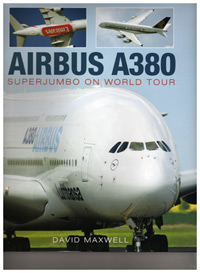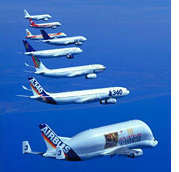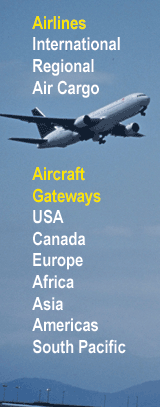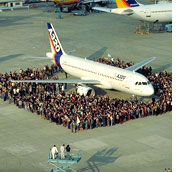|

Airbus develops,
produces and supports commercial aircraft in the 100
seat and above range. In 2001 Airbus became
a single fully integrated company incorporated under
French law as a simplified joint stock company. The four
national entities which had previously formed the Airbus
consortium transferred their Airbus-related assets to
the new company and became shareholders in Airbus --
Airbus France,
Airbus Deutschland and Airbus Espana merging as the European
Aeronautic Defence and Space Company (EADS)
with 80% shares and BAE
Systems with
20%. In 2006, following the sales of BAE Systems'
shares, Airbus became an EADS company.
Manufacturing, production and sub-assembly of parts for
Airbus aircraft are distributed around 12 sites in
Europe, with final assembly in Toulouse and Hamburg.There
are also centres for engineering design, sales and
support in North America; and sales and customer support
centres in Japan and China.
Airbus has a joint engineering centre inRussia with
Kaskol.
Airbus is managed by an Executive Committee headed by a
President and Chief Executive Officer appointed by the
EADS Board of Direction.
AIRBUS GROUP TEAMS UP WITH AERION
Sep 22, 2014
WASHINGTON, DC and RENO, NV- Airbus Group
and Aerion Corporation have agreed to
collaborate on technologies associated with
the future of high-performance flight. To
further their mutual objectives, both
companies will exchange knowledge and
capabilities in design, manufacturing and
certification.
For Aerion, this means collaboration to
advance the development and
commercialization of the Aerion AS2
supersonic business jet.
Under the agreement, Airbus Group,
through its Defence and Space division,
will provide technical and certification
support, which will include the
assignment of senior engineering staff
to Aerion's expanding development
organization. Aerion and Airbus Defence
and Space professionals will work
together at Aerion's new and larger
engineering offices in Reno, Nevada.
"This is a major step forward for Aerion,"
said the company's chairman and
principal investor, Robert M. Bass. "It
puts us solidly on track toward our
objective of certifying the world's
first supersonic business jet in 2021.
Needless to say, we are thrilled with
the resources Airbus Group will bring to
the program."
Over the longer term, Aerion will
provide proprietary technology and
assistance to Airbus Group in its
high-performance aircraft technology
development. These technologies include
Aerion's extensive research, its
proprietary design tools and patented
aerodynamic designs.
"Aerion's pioneering work has broad
applications for both performance and
efficiency. We are looking forward to a
fruitful cooperation," said Jean Botti,
Airbus Group Chief Technical Officer.
The joint effort provides expanded
engineering capabilities to Aerion as it
enters a design phase in which
propulsion systems, structures, avionics
and equipment are specified and sourced.
Under the current timeline, Aerion is
targeting first flight of the AS2 in the
2019 timeframe.
"This agreement accomplishes two major
objectives," according to Aerion CEO
Doug Nichols. "It provides validation
from the industry leader in aerospace
innovation, and it decisively kicks the
program into high gear. Each company
will benefit. Aerion moves quickly
toward building a supersonic jet, and
Airbus Group gains exclusive access to
more than a decade of successful
research and proprietary
high-performance aircraft technology."
Initial collaboration activities have
commenced between engineering teams from
Aerion and Airbus Defence and Space,
which is Airbus Group's principal
liaison organization for AS2
development.
AIRBUS
BOOKS ALMOST $70 BILLION AT 2013 PARIS
AIR SHOW
Jun 20, 2013
At the 2013 Paris Air Show,
Airbus won US$68.7 billion worth
of business for a total of 466
aircraft, which shows the
resilience of the commercial
aviation industry. The deals
comprise Memoranda of
Understanding (MoU) for 225
aircraft worth US$29.4 billion
and firm purchase orders for 241
aircraft worth US$39.3 billion.
The A320 Family, spearheaded by
the A320neo, continues its
trailblazing success in the
single-aisle market with 371
orders and commitments from six
customers announced at the show,
worth approximately $37.8
billion. Of these, 88 were for
the A320ceo – showing that
today’s in-production aircraft
is still the most sought-after
industry workhorse. A stand-out
commitment during the show for
the A320 Family was the
announcement from easyJet for
100 A320neos plus 35 A320ceos –
the winning result of a very
intense competition. Another
major endorsement for the A320
Family came from Lufthansa with
the firming-up of 100 more
aircraft. Additional A320 Family
orders and commitments came
from: Hong Kong Aviation Capital
for 60; ILFC for 50; Spirit for
20; and Tunisia’s Syphax
Airlines for three –
significantly the first A320neo
commitment from Africa.
Another star at Paris was the
A350 XWB which flew for the
first time on Friday 14th June
2013 and successfully completed
its second flight on Wednesday
19th June. At the show this
aircraft gained 69 more orders &
commitments worth $21.4 billion
from four customers on different
continents. Air France-KLM
placed a firm order for 25
A350-900s. Meanwhile, Singapore
Airlines, already a large
customer for the type, returned
to order 30 more A350-900s;
United Airlines also placed an
additional A350 order for 10
A350-1000s -- not only bringing
its total A350 orders to 35, but
also upgrading its previous
order for 25 A350-900s to the
larger A350-1000 model to
replace its Boeing 777s. In
addition, Sri Lankan signed a
commitment for four A350-900s to
complement an order for six
A330-300s at the show.
At the top end of the product
range, the flagship A380
received a commitment for 20
aircraft from the world’s third
largest wide-body lessor, Doric
Lease Corp, in a deal worth more
than $8 billion. The contract
with Doric is significant as it
opens up a new, additional route
to market for the A380, which is
now available to airlines who
wish to acquire the aircraft
under the flexibility of an
operating lease agreement.
John Leahy, Airbus’s Chief
Operating Officer, Customers
said: “The dramatic rainfall and
thunder storms at Le Bourget
this year didn’t dampen our
order intake.” He added: “Our
A350 XWB has been out-selling
the 787 by better than 2- to-1
over the last five years. In
addition our A320neo Family
retains a 60 percent market
share lead. That’s a ‘corner’ I
want to stay boxed into.”
In addition to aircraft order
announcements, this year’s show
saw some operators take delivery
of new Airbus aircraft. Most
notably, LATAM Airlines Group,
one of Airbus’ largest A320
customers, received its 200th
A320 at Le Bourget. The aircraft
was fitted with Sharklet
fuel-saving wingtip devices – an
option now proving to be
universally popular on this
family of aircraft. Meanwhile
Air New Zealand – the launch
airline to commit to these fuel
saving devices – took delivery
of its first A320 equipped with
Sharklets. In addition, VIP
operator Comlux took delivery of
the first Airbus ACJ321, which
will make it the first Airbus
Corporate Jet customer to have
every Airbus A320 Family member
in its fleet.
AIRBUS:
FROM A SINGLE AIRCRAFT TO A COMPLETE
FAMILY
 By
taking the right decisions at the start, Airbus has
been able to create a complete range of aircraft
that exceed the expectations of passengers, pilots
and operators -- all within 30 years. Airbus was
established in 1970 as a European consortium of
French, German and later, Spanish and U.K
companies, as it became clear that only by
co-operating would European aircraft manufacturers
be able to compete effectively with the U.S.
giants. By overcoming national divides, sharing
development costs, collaborating in the interests
of a greater market share, and even agreeing a
common set of measurements and a common language,
Airbus changed the face of the business, and
brought airlines, passengers and crews the benefits
of real competition. In 2001, thirty years after
its creation, Airbus formally became a single
integrated company, thus passing another major
milestone in its history of achievements. By
taking the right decisions at the start, Airbus has
been able to create a complete range of aircraft
that exceed the expectations of passengers, pilots
and operators -- all within 30 years. Airbus was
established in 1970 as a European consortium of
French, German and later, Spanish and U.K
companies, as it became clear that only by
co-operating would European aircraft manufacturers
be able to compete effectively with the U.S.
giants. By overcoming national divides, sharing
development costs, collaborating in the interests
of a greater market share, and even agreeing a
common set of measurements and a common language,
Airbus changed the face of the business, and
brought airlines, passengers and crews the benefits
of real competition. In 2001, thirty years after
its creation, Airbus formally became a single
integrated company, thus passing another major
milestone in its history of achievements.
The European
Aeronautic Defence and Space Company (EADS),
(resulting from the merger between Aerospatiale
Matra SA of France, Daimler Chrysler Aerospace AG
of Germany and Construcciones Aeronauticas SA of
Spain), and BAE SYSTEMS of the UK, transferred all
of their Airbus-related assets to the newly
incorporated company and, in exchange, became
shareholders in Airbus with 80 per cent and 20 per
cent respectively of the new stock.
 The
co-operation between the different entities that
make up Airbus today goes back to the 1920s.
Construcciones Aeronauticas S.A. (CASA) of Spain
built seaplanes under licence from German company
Dornier and worked with the French on the
Bréguet XIX. Then in the 1950s, a number of
Franco-German aviation projects saw the light of
day. The 1960s saw the first real co-operative
effort between French and German aircraft
manufacturers on the Transall, followed by the
Concorde adventure between the French and the
British. The
co-operation between the different entities that
make up Airbus today goes back to the 1920s.
Construcciones Aeronauticas S.A. (CASA) of Spain
built seaplanes under licence from German company
Dornier and worked with the French on the
Bréguet XIX. Then in the 1950s, a number of
Franco-German aviation projects saw the light of
day. The 1960s saw the first real co-operative
effort between French and German aircraft
manufacturers on the Transall, followed by the
Concorde adventure between the French and the
British.
This was also a
time of close contacts between CASA and
Messerschmidt-Bölkow-Blohm (MBB). MBB formed
the core of DaimlerChrysler Aerospace AG (DASA) in
1989 and then CASA, Dasa and Aerospatiale Matra
S.A. together formed EADS in 2000.
The Airbus GIE (or
Groupement d'Intérêt Economique), a
form of consortium under French law, was officially
created at the end of 1970 to establish a formal
co-operation among the GIE's partners and to
provide a single sales, marketing and support
interface for Airbus customers.
The two full
partners in the original consortium were
Aerospatiale for France and Deutsche Aerospace for
Germany. Hawker Siddeley and Fokker were also
associated with the programme and CASA of Spain
became a full member of the GIE in 1971.
Initially
headquartered in Paris, the GIE moved to Toulouse
in 1974. British Aerospace became a full partner in
1979.
Airbus' first
aircraft, the A300B, was launched at the 1969 Paris
air show. It was the first widebody twinjet and
could carry 226 passengers in a comfortable
two-class lay-out. A stretched 250 seat version,
the A300B2, requested by launch customer Air
France, went into full scale production.
By 1974, the A300
had been certified on budget and ahead of schedule
&endash; a major first for European companies at
the time. By the end of 1975, Airbus had 10 per
cent of the market and a total of 55 aircraft on
order. The company then went through a dark period,
during which it failed to secure any new orders.
Finally, US airline Eastern Airlines decided to
lease four A300B4s.
This was a turning
point, and from then on, Airbus never looked back.
Within two years, Airbus had 133 firm orders and
market share had risen to 26 per cent by value. By
the end of 1979, Airbus had 256 orders from 32
customers and 81 aircraft in service with 14
operators.
In July 1978,
Airbus launched the A310, a shortened version of
the A300 seating 218 passengers in a standard,
two-class configuration. The aircraft featured the
first ever two-man cockpit equipped with six
cathode ray tubes displays replacing the older
dials.
No longer was
Airbus a one-aircraft manufacturer. It was set to
expand and to create a complete range of
airliners.
Following this
bold stroke, British Aerospace - which had taken
over Hawker-Siddeley - became a full partner in the
Airbus consortium in 1979. All the major European
manufacturers were now firmly united and ready to
challenge the U.S. industry.
That same year,
Airbus decided to incorporate the 130-170 seat
single aisle aircraft, on which the partners had
been working outside the consortium, into its
aircraft family. This project became the A320,
which filled out the Airbus product line and
allowed Airbus to compete for replacements of
ageing U.S.-built aircraft in that category, in
service worldwide at the time.
The A320, launched
in 1984, was the first all-new design in its
category in 30 years. Incorporating new
technologies, the aircraft provided better
operating efficiency, better performance and -
above all - greater passenger comfort thanks to a
wider fuselage cross-section. It was the first
commercial aircraft to feature 'fly-by-wire'
controls and side sticks. It set the standard for
all subsequent Airbus cockpits and indeed for the
industry as a whole.
The introduction
of fly-by-wire also enabled Airbus to develop a
family of aircraft sharing the same cockpit and the
same flight handling characteristics.
The A320 was
followed in 1989 by the A321, a lengthened version,
seating 185 passengers in a standard three class
configuration, and, in 1992, by a 124-seat version
- the A319. The single-aisle Family was completed
in 1999 with the introduction of the 107-seat
A318.
The decision to
launch the A320 proved a wise one. In spite of the
recession of the mid 80s, the aircraft anticipated
market demand for a modern, cost-efficient aircraft
to replace older planes when the economy turned
round. The new A320 was quickly chosen by Air
France, British Caledonian, Adria Airways, Air
Inter and Cyprus Airways. Today, it is one of
Airbus' best-selling aircraft, popular with
passengers and carriers alike.
By 1987, it was
clear to Airbus that the time was ripe to launch
not one, but two larger aircraft in a single
programme. The market was ready for a twin engine,
medium-haul aircraft as well as a long range, four
engine, airliner.
The two new
airliners shared the same airframe, the same wing
design and the same popular twin-aisle
cross-section as the A300/A310, incorporating the
proven fly-by-wire controls of the A320.
When the
four-engine A340 entered service in 1993, it was
the first entirely new, long-haul aircraft to start
commercial operations for more than 20 years. The
twin-engine A330 which joined it a year later
combined some of the lowest operating costs of any
aircraft ever designed with maximum flexibility for
a wide range of route structures.
Two additional
versions of the A340, the A340-500 and the
A340-600, have been developed in close
collaboration with airlines. The A340-600 achieved
certification in May 2002 and entered airline
service in August while its sibling, the A340-500,
achieved certification in December 2002.
In December 2000,
Airbus launched the 555-seat A380 programme at the
top end of the spectrum. This all-new double-decker
aircraft is the most advanced, spacious and
efficient airliner ever conceived, and the solution
to growing traffic between major hubs.
The A380 will
provide 15 to 20 per cent lower operating costs, 10
to 15 per cent more range, lower fuel burn, less
noise and lower emissions than the largest aircraft
flying today.
http://www.airbus.com/

|




 By
taking the right decisions at the start, Airbus has
been able to create a complete range of aircraft
that exceed the expectations of passengers, pilots
and operators -- all within 30 years. Airbus was
established in 1970 as a European consortium of
French, German and later, Spanish and U.K
companies, as it became clear that only by
co-operating would European aircraft manufacturers
be able to compete effectively with the U.S.
giants. By overcoming national divides, sharing
development costs, collaborating in the interests
of a greater market share, and even agreeing a
common set of measurements and a common language,
Airbus changed the face of the business, and
brought airlines, passengers and crews the benefits
of real competition. In 2001, thirty years after
its creation, Airbus formally became a single
integrated company, thus passing another major
milestone in its history of achievements.
By
taking the right decisions at the start, Airbus has
been able to create a complete range of aircraft
that exceed the expectations of passengers, pilots
and operators -- all within 30 years. Airbus was
established in 1970 as a European consortium of
French, German and later, Spanish and U.K
companies, as it became clear that only by
co-operating would European aircraft manufacturers
be able to compete effectively with the U.S.
giants. By overcoming national divides, sharing
development costs, collaborating in the interests
of a greater market share, and even agreeing a
common set of measurements and a common language,
Airbus changed the face of the business, and
brought airlines, passengers and crews the benefits
of real competition. In 2001, thirty years after
its creation, Airbus formally became a single
integrated company, thus passing another major
milestone in its history of achievements.
 The
co-operation between the different entities that
make up Airbus today goes back to the 1920s.
Construcciones Aeronauticas S.A. (CASA) of Spain
built seaplanes under licence from German company
Dornier and worked with the French on the
Bréguet XIX. Then in the 1950s, a number of
Franco-German aviation projects saw the light of
day. The 1960s saw the first real co-operative
effort between French and German aircraft
manufacturers on the Transall, followed by the
Concorde adventure between the French and the
British.
The
co-operation between the different entities that
make up Airbus today goes back to the 1920s.
Construcciones Aeronauticas S.A. (CASA) of Spain
built seaplanes under licence from German company
Dornier and worked with the French on the
Bréguet XIX. Then in the 1950s, a number of
Franco-German aviation projects saw the light of
day. The 1960s saw the first real co-operative
effort between French and German aircraft
manufacturers on the Transall, followed by the
Concorde adventure between the French and the
British.